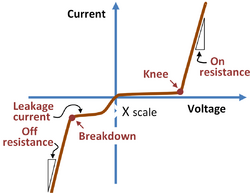User:John R. Brews/Draft: Difference between revisions
imported>John R. Brews No edit summary |
imported>John R. Brews No edit summary |
||
| Line 6: | Line 6: | ||
==Electrical behavior== | ==Electrical behavior== | ||
{{Image|Nonideal diode current-voltage behavior.PNG|right|250px|Nonideal diode current-voltage characteristics.}} | {{Image|Nonideal diode current-voltage behavior.PNG|right|250px|Nonideal diode current-voltage characteristics.}} | ||
The ideal diode has | The ideal diode has zero resistance for the ''forward bias polarity'', and infinite resistance (conducts zero current) for the ''reverse voltage polarity''. The ''pn-diode'' is not ideal. As shown in the figure, the diode does not conduct appreciably until a nonzero ''knee voltage'' is reached. Above this voltage the slope of the current-voltage curve is not infinite, but exhibits a nonzero forward resistance. In the reverse direction the diode conducts a nonzero leakage current (exaggerated by a smaller scale in the figure) and at a sufficiently large reverse voltage above the ''breakdown voltage'' the current increases very rapidly with larger reverse voltages. | ||
Revision as of 17:00, 8 January 2011
A semiconductor diode is a two-terminal device that conducts current in only one direction, made by joining a p-type semiconducting layer to an n-type semiconducting layer.
Electrical behavior
The ideal diode has zero resistance for the forward bias polarity, and infinite resistance (conducts zero current) for the reverse voltage polarity. The pn-diode is not ideal. As shown in the figure, the diode does not conduct appreciably until a nonzero knee voltage is reached. Above this voltage the slope of the current-voltage curve is not infinite, but exhibits a nonzero forward resistance. In the reverse direction the diode conducts a nonzero leakage current (exaggerated by a smaller scale in the figure) and at a sufficiently large reverse voltage above the breakdown voltage the current increases very rapidly with larger reverse voltages.
